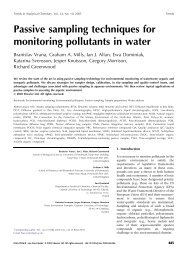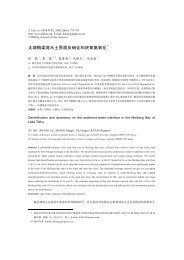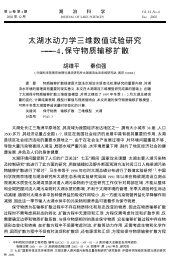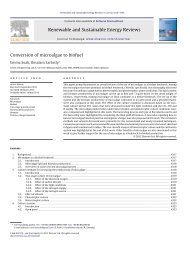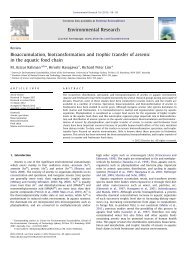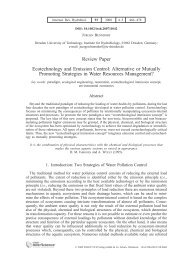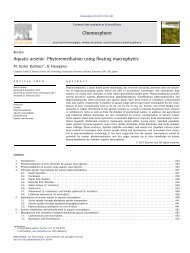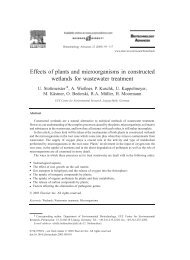- Page 2:
This page intentionally left blank
- Page 6:
ecology, biodiversity, and conserva
- Page 10:
cambridge university press Cambridg
- Page 16:
Contents Preface Acknowledgements p
- Page 20:
References Index to lakes, rivers a
- Page 26:
xii PREFACE questions the very conc
- Page 30:
Acknowledgements Except where state
- Page 34:
2 PHYTOPLANKTON In this way, plankt
- Page 38:
4 PHYTOPLANKTON ecosystems, Hensen
- Page 42:
6 PHYTOPLANKTON Table 1.1 Survey of
- Page 46:
8 PHYTOPLANKTON Table 1.1 (cont.) P
- Page 50:
10 PHYTOPLANKTON Table 1.1 (cont.)
- Page 54:
12 PHYTOPLANKTON of producing popul
- Page 58:
14 PHYTOPLANKTON The relatively rec
- Page 62:
16 PHYTOPLANKTON reveals a commensu
- Page 66:
18 PHYTOPLANKTON mechanisms for inc
- Page 70:
20 PHYTOPLANKTON Table 1.2 Nominal
- Page 74:
22 PHYTOPLANKTON Notes to Table 1.2
- Page 78:
24 PHYTOPLANKTON attenuated cells (
- Page 82:
26 PHYTOPLANKTON Table 1.3 Air-dry
- Page 86:
28 PHYTOPLANKTON Volcani, 1981). In
- Page 90:
30 PHYTOPLANKTON Figure 1.9 The sil
- Page 94:
32 PHYTOPLANKTON Analogous argument
- Page 98:
34 PHYTOPLANKTON Cell chlorophyll a
- Page 102:
36 PHYTOPLANKTON Figure 1.11 Log/lo
- Page 106:
Chapter 2 Entrainment and distribut
- Page 110:
40 ENTRAINMENT AND DISTRIBUTION IN
- Page 114:
42 ENTRAINMENT AND DISTRIBUTION IN
- Page 118:
44 ENTRAINMENT AND DISTRIBUTION IN
- Page 122:
46 ENTRAINMENT AND DISTRIBUTION IN
- Page 126:
48 ENTRAINMENT AND DISTRIBUTION IN
- Page 130:
50 ENTRAINMENT AND DISTRIBUTION IN
- Page 134:
52 ENTRAINMENT AND DISTRIBUTION IN
- Page 138:
54 ENTRAINMENT AND DISTRIBUTION IN
- Page 142:
56 ENTRAINMENT AND DISTRIBUTION IN
- Page 146:
58 ENTRAINMENT AND DISTRIBUTION IN
- Page 150:
60 ENTRAINMENT AND DISTRIBUTION IN
- Page 154:
62 ENTRAINMENT AND DISTRIBUTION IN
- Page 158:
64 ENTRAINMENT AND DISTRIBUTION IN
- Page 162:
66 ENTRAINMENT AND DISTRIBUTION IN
- Page 166:
68 ENTRAINMENT AND DISTRIBUTION IN
- Page 170:
70 ENTRAINMENT AND DISTRIBUTION IN
- Page 174:
72 ENTRAINMENT AND DISTRIBUTION IN
- Page 178:
74 ENTRAINMENT AND DISTRIBUTION IN
- Page 182:
76 ENTRAINMENT AND DISTRIBUTION IN
- Page 186:
78 ENTRAINMENT AND DISTRIBUTION IN
- Page 190:
80 ENTRAINMENT AND DISTRIBUTION IN
- Page 194:
82 ENTRAINMENT AND DISTRIBUTION IN
- Page 198:
84 ENTRAINMENT AND DISTRIBUTION IN
- Page 202:
86 ENTRAINMENT AND DISTRIBUTION IN
- Page 206:
88 ENTRAINMENT AND DISTRIBUTION IN
- Page 210:
90 ENTRAINMENT AND DISTRIBUTION IN
- Page 214:
92 ENTRAINMENT AND DISTRIBUTION IN
- Page 218:
94 PHOTOSYNTHESIS AND CARBON ACQUIS
- Page 222:
96 PHOTOSYNTHESIS AND CARBON ACQUIS
- Page 226:
98 PHOTOSYNTHESIS AND CARBON ACQUIS
- Page 230:
100 PHOTOSYNTHESIS AND CARBON ACQUI
- Page 234:
102 PHOTOSYNTHESIS AND CARBON ACQUI
- Page 238:
104 PHOTOSYNTHESIS AND CARBON ACQUI
- Page 242:
106 PHOTOSYNTHESIS AND CARBON ACQUI
- Page 246:
108 PHOTOSYNTHESIS AND CARBON ACQUI
- Page 250:
110 PHOTOSYNTHESIS AND CARBON ACQUI
- Page 254:
112 PHOTOSYNTHESIS AND CARBON ACQUI
- Page 258:
114 PHOTOSYNTHESIS AND CARBON ACQUI
- Page 262:
116 PHOTOSYNTHESIS AND CARBON ACQUI
- Page 266:
118 PHOTOSYNTHESIS AND CARBON ACQUI
- Page 270:
120 PHOTOSYNTHESIS AND CARBON ACQUI
- Page 274:
122 PHOTOSYNTHESIS AND CARBON ACQUI
- Page 278:
124 PHOTOSYNTHESIS AND CARBON ACQUI
- Page 282:
126 PHOTOSYNTHESIS AND CARBON ACQUI
- Page 286:
128 PHOTOSYNTHESIS AND CARBON ACQUI
- Page 290:
130 PHOTOSYNTHESIS AND CARBON ACQUI
- Page 294:
132 PHOTOSYNTHESIS AND CARBON ACQUI
- Page 298:
134 PHOTOSYNTHESIS AND CARBON ACQUI
- Page 302:
136 PHOTOSYNTHESIS AND CARBON ACQUI
- Page 306:
138 PHOTOSYNTHESIS AND CARBON ACQUI
- Page 310:
140 PHOTOSYNTHESIS AND CARBON ACQUI
- Page 314:
142 PHOTOSYNTHESIS AND CARBON ACQUI
- Page 318:
144 PHOTOSYNTHESIS AND CARBON ACQUI
- Page 322:
146 NUTRIENT UPTAKE AND ASSIMILATIO
- Page 326:
148 NUTRIENT UPTAKE AND ASSIMILATIO
- Page 330:
150 NUTRIENT UPTAKE AND ASSIMILATIO
- Page 334:
152 NUTRIENT UPTAKE AND ASSIMILATIO
- Page 338:
154 NUTRIENT UPTAKE AND ASSIMILATIO
- Page 342:
156 NUTRIENT UPTAKE AND ASSIMILATIO
- Page 346:
158 NUTRIENT UPTAKE AND ASSIMILATIO
- Page 350:
160 NUTRIENT UPTAKE AND ASSIMILATIO
- Page 354:
162 NUTRIENT UPTAKE AND ASSIMILATIO
- Page 358:
164 NUTRIENT UPTAKE AND ASSIMILATIO
- Page 362:
166 NUTRIENT UPTAKE AND ASSIMILATIO
- Page 366:
168 NUTRIENT UPTAKE AND ASSIMILATIO
- Page 370:
170 NUTRIENT UPTAKE AND ASSIMILATIO
- Page 374:
172 NUTRIENT UPTAKE AND ASSIMILATIO
- Page 378:
174 NUTRIENT UPTAKE AND ASSIMILATIO
- Page 382:
176 NUTRIENT UPTAKE AND ASSIMILATIO
- Page 386:
Chapter 5 Growth and replication of
- Page 390:
180 GROWTH AND REPLICATION OF PHYTO
- Page 394:
182 GROWTH AND REPLICATION OF PHYTO
- Page 398:
184 GROWTH AND REPLICATION OF PHYTO
- Page 402:
186 GROWTH AND REPLICATION OF PHYTO
- Page 406:
188 GROWTH AND REPLICATION OF PHYTO
- Page 410:
190 GROWTH AND REPLICATION OF PHYTO
- Page 414:
192 GROWTH AND REPLICATION OF PHYTO
- Page 418:
194 GROWTH AND REPLICATION OF PHYTO
- Page 422:
196 GROWTH AND REPLICATION OF PHYTO
- Page 426:
198 GROWTH AND REPLICATION OF PHYTO
- Page 430:
200 GROWTH AND REPLICATION OF PHYTO
- Page 434:
202 GROWTH AND REPLICATION OF PHYTO
- Page 438:
204 GROWTH AND REPLICATION OF PHYTO
- Page 442:
206 GROWTH AND REPLICATION OF PHYTO
- Page 446:
208 GROWTH AND REPLICATION OF PHYTO
- Page 450:
210 GROWTH AND REPLICATION OF PHYTO
- Page 454:
212 GROWTH AND REPLICATION OF PHYTO
- Page 458:
214 GROWTH AND REPLICATION OF PHYTO
- Page 462:
216 GROWTH AND REPLICATION OF PHYTO
- Page 466:
218 GROWTH AND REPLICATION OF PHYTO
- Page 470:
220 GROWTH AND REPLICATION OF PHYTO
- Page 474:
222 GROWTH AND REPLICATION OF PHYTO
- Page 478:
224 GROWTH AND REPLICATION OF PHYTO
- Page 482:
226 GROWTH AND REPLICATION OF PHYTO
- Page 486:
228 GROWTH AND REPLICATION OF PHYTO
- Page 490:
230 GROWTH AND REPLICATION OF PHYTO
- Page 494:
232 GROWTH AND REPLICATION OF PHYTO
- Page 498:
234 GROWTH AND REPLICATION OF PHYTO
- Page 502:
236 GROWTH AND REPLICATION OF PHYTO
- Page 506: 238 GROWTH AND REPLICATION OF PHYTO
- Page 510: 240 MORTALITY AND LOSS PROCESSES IN
- Page 514: 242 MORTALITY AND LOSS PROCESSES IN
- Page 518: 244 MORTALITY AND LOSS PROCESSES IN
- Page 522: 246 MORTALITY AND LOSS PROCESSES IN
- Page 526: 248 MORTALITY AND LOSS PROCESSES IN
- Page 530: 250 MORTALITY AND LOSS PROCESSES IN
- Page 534: 252 MORTALITY AND LOSS PROCESSES IN
- Page 538: 254 MORTALITY AND LOSS PROCESSES IN
- Page 542: 256 MORTALITY AND LOSS PROCESSES IN
- Page 546: 258 MORTALITY AND LOSS PROCESSES IN
- Page 550: 260 MORTALITY AND LOSS PROCESSES IN
- Page 554: 262 MORTALITY AND LOSS PROCESSES IN
- Page 560: Quantitatively, the best studied of
- Page 564: Possibly the most pertinent deducti
- Page 568: Thompson et al. (1982) found that t
- Page 572: Box 6.1 On the sticky question of m
- Page 576: CONSUMPTION BY HERBIVORES 273 quick
- Page 580: d = 26 µm). These increases were n
- Page 584: CONSUMPTION BY HERBIVORES 277 Table
- Page 588: carnivorous in the later copepodite
- Page 592: CONSUMPTION BY HERBIVORES 281 Box 6
- Page 596: CONSUMPTION BY HERBIVORES 283 Some
- Page 600: CONSUMPTION BY HERBIVORES 285 Table
- Page 604: although the authors noted that nei
- Page 608:
native species and a greater variet
- Page 612:
Food-chain length The examples give
- Page 616:
The most conspicuous fungal parasit
- Page 620:
presumably, to facilitate transfer
- Page 624:
are probably exaggerated. However,
- Page 628:
prevents it from increasing at all
- Page 632:
esource that is available to direct
- Page 636:
SPECIES COMPOSITION AND TEMPORAL CH
- Page 640:
Even the permanent pycnocline, loca
- Page 644:
of the Kuroshio Current (roughly, f
- Page 648:
The Coriolis forces acting on the f
- Page 652:
though this is under way at least a
- Page 656:
eutrophication from its main influe
- Page 660:
Figure 7.3 The ‘intaglio’ (of S
- Page 664:
to the Prochlorococcus-dominated am
- Page 668:
phytosociologists to diagnose plant
- Page 672:
Table 7.1 (cont.) SPECIES COMPOSITI
- Page 676:
over fixed carbon to the microbial
- Page 680:
calmer conditions, the Cyanobacteri
- Page 684:
et al., 1997). Originally identifie
- Page 688:
SPECIES COMPOSITION AND TEMPORAL CH
- Page 692:
SPECIES COMPOSITION AND TEMPORAL CH
- Page 696:
All these lakes can support signifi
- Page 700:
its dynamics coincide sufficiently
- Page 704:
and Black Sea watersheds in that co
- Page 708:
(C/D/Y → X1/X2/Y/E → H1/F → L
- Page 712:
of the intensification of the therm
- Page 716:
On this basis, some ‘large lakes
- Page 720:
Finally, many shallow, hypertrophic
- Page 724:
Table 7.6 Sensitivities to habitat
- Page 728:
Figure 7.8 (a) Habitat template for
- Page 732:
matter, cohabitant microbes, zoopla
- Page 736:
point that needs to be emphasised i
- Page 740:
over a12-year period, Venrick (1990
- Page 744:
adiation (Qs) as heat (units, W m
- Page 748:
an attendant increase in transparen
- Page 752:
Table 7.7 Attributes of early and m
- Page 756:
Figure 7.14 Idealised environments,
- Page 760:
intense is the competition for the
- Page 764:
Figure 7.17 Periodicity of dominant
- Page 768:
against Hardin’s (1960) principle
- Page 772:
various states of ecological disequ
- Page 776:
weather conditions (hurricanes, flo
- Page 780:
in Connell’s (1978) hypothesis an
- Page 784:
duration and the physiological resi
- Page 788:
Figure 7.24 Annual mean Shannon div
- Page 792:
the 100 or so commonly encountered
- Page 796:
independently of which species had
- Page 800:
similarity of seasonal pattern amon
- Page 804:
Chapter 8 Phytoplankton ecology and
- Page 808:
is suggested to be 5-80 mg C m −3
- Page 812:
the turnover of carbon than nutrien
- Page 816:
the order 1-10 g Cm −2 . Larger c
- Page 820:
/ / Processing fluxes Figure 8.2 Lo
- Page 824:
Figure 8.4 Sketch to show several a
- Page 828:
systems in general. Reynolds and Da
- Page 832:
Table 8.1 Proposed criteria for cla
- Page 836:
et al., 1964). The work was continu
- Page 840:
generate a toxic dose in 28 L of la
- Page 844:
implicit confidence in the techniqu
- Page 848:
Figure 8.7 Stages in the recovery o
- Page 852:
stage 1 to a P-led biomass reductio
- Page 856:
through their physical penetration
- Page 860:
supportable concentration is closer
- Page 864:
efficient traits (discussion in Sec
- Page 868:
associated with a strong presence o
- Page 872:
epiphytic and some planktic algae t
- Page 876:
state has become too firmly establi
- Page 880:
phytoplankton, tolerance of natural
- Page 884:
eplacement by ‘sea urchin barrens
- Page 888:
Starting with what we know, the glo
- Page 892:
carbon-exporting elements of the pe
- Page 896:
state, a low, stable, average bioma
- Page 900:
50% of the area is
- Page 904:
Glossary Text boxes are used to exp
- Page 908:
eflection, absorption or consumptio
- Page 912:
L litre, a customary unit of volume
- Page 916:
Rib bulk Richardson number, being t
- Page 920:
z(0.5I k) depth beneath the water s
- Page 924:
References Abeliovich, A. and Shilo
- Page 928:
Productivity, ed. P. J. leB. Willia
- Page 932:
Bowen, C. C. and Jensen, T. E. (196
- Page 936:
(1980). Some general observations o
- Page 940:
shallow lake, with special referenc
- Page 944:
Sensing, ed.F.M. Danson and S. E. P
- Page 948:
Algal Blooms, ed.D. M. Anderson, A.
- Page 952:
(2002). Global dispersal of free-li
- Page 956:
(2002). Regional scale influences o
- Page 960:
northern pike, aquatic vegetation a
- Page 964:
Heaney, S. I., Canter, H. M. and Lu
- Page 968:
Huisman, J. and Sommeijer, B. (2002
- Page 972:
on growth and sinking rate of two p
- Page 976:
Kierstead, H. and Slobodkin, L. B.
- Page 980:
y various predators. Microbial Ecol
- Page 984:
Levich, A. P. (1996). The role of n
- Page 988:
Lund, J. W. G., Kipling, C. and Le
- Page 992:
(1987). Trophic dynamics and develo
- Page 996:
organisms in a hypereutrophic pond.
- Page 1000:
Owens, O. van H. and Esaias, W. (19
- Page 1004:
(1999). Spatial structure of pelagi
- Page 1008:
composition of plankton. In The Jam
- Page 1012:
(2000a). Phytoplankton designer or
- Page 1016:
Richey, J. E., Melack, J. M. Aufdem
- Page 1020:
Sarmiento, J. L. and Wofsy, S. C. (
- Page 1024:
Sirenko, L. A., Stetsenko, N. M., A
- Page 1028:
Spencer, M. and Warren, P. H. (1996
- Page 1032:
(1957a). Diurnal changes of stratif
- Page 1036:
growth rate of Microcystis (Cyanoba
- Page 1040:
Walsby, A. E., Utkilen, H. C. and J
- Page 1044:
Microcystis aeruginosa hyperscums f
- Page 1048:
Lowes Water, UK 54 ◦ 34 ′ N, 3
- Page 1052:
Index to genera and species of phyt
- Page 1056:
Chromulina (Chrysophyta CHROMULINAL
- Page 1060:
Glaucocystis (Glaucophyta) F6 Table
- Page 1064:
Peridinium gatunense Nygaard F, LO
- Page 1068:
Synedra ulna (Nitzsch) Ehrenb. F, B
- Page 1072:
Daphnia galeata 221, 261, 266, 266
- Page 1076:
Tropocyclops Crustacea, Cyclopoidea
- Page 1080:
own tides, 407 bryophytes, 11 bryoz
- Page 1084:
‘swimming’ velocities, 68; vita
- Page 1088:
keystone species, 382, 394, 427 kin
- Page 1092:
particulate organic matter (POM), 3
- Page 1096:
quantum yield of photosynthesis, 98
- Page 1100:
vertical migration of phytoplankton



